Two days ago I photographed a coyote biting off and eating a duck’s head and leaving the rest of the carcass behind. Yesterday morning I photographed a different coyote doing the same thing, twice. I have to wonder why they’re doing it.
Once again many of my photos of this behavior were soft, most likely because I was shooting a moving subject in deep shade and/or because the action began immediately after I arrived at my destination so at the beginning I was shooting with a warm lens in cold temperatures – causing lens contraction issues. But I think the images are sharp enough for documentary purposes.
Note to the squeamish. No blood or guts can be seen in this series but some of the photos may be quite unsettling, even gruesome, for some viewers. So please, if you choose to proceed, no complaints about what you’ve seen.
You have been warned.
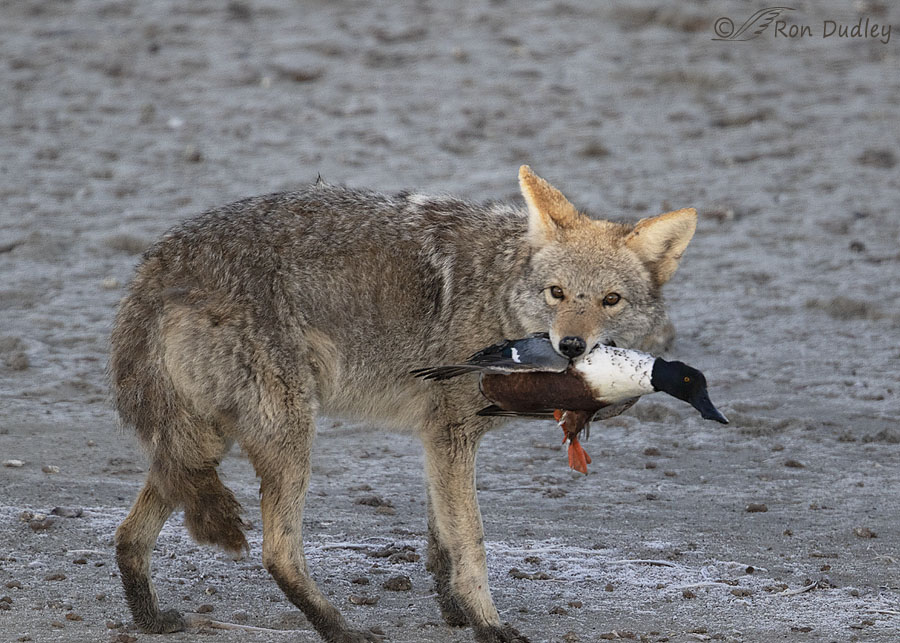
Yesterday morning on the Antelope Island causeway this coyote walked east and toward me from the island soon after dawn. Based mostly on size I believe it’s a male but I could be wrong. It’s a different coyote from the two coyotes I photographed two days ago. His feet and the end of his tail were muddy and possibly still wet.
He strolled over almost nonchalantly and picked up this male Northern Shoveler on the beach that I hadn’t noticed earlier. The shoveler was apparently disabled because it made no attempt to avoid the coyote, none at all, even though at this point it was obviously still alive and even alert.
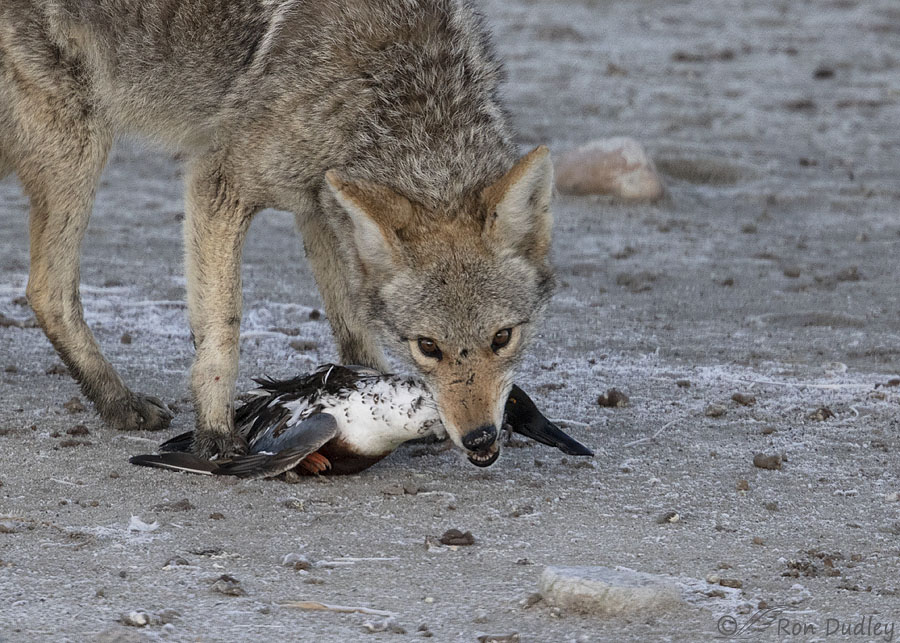
He grasped the shoveler by the neck and with two chomps (I could tell when he was biting down hard because he closed his eyes each time) he…
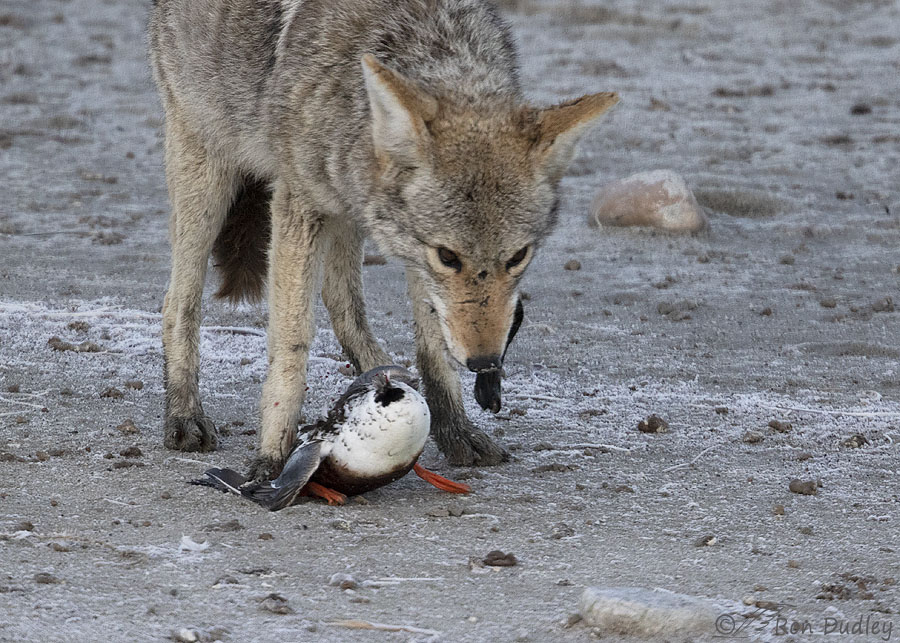
severed the duck’s neck at its base and…
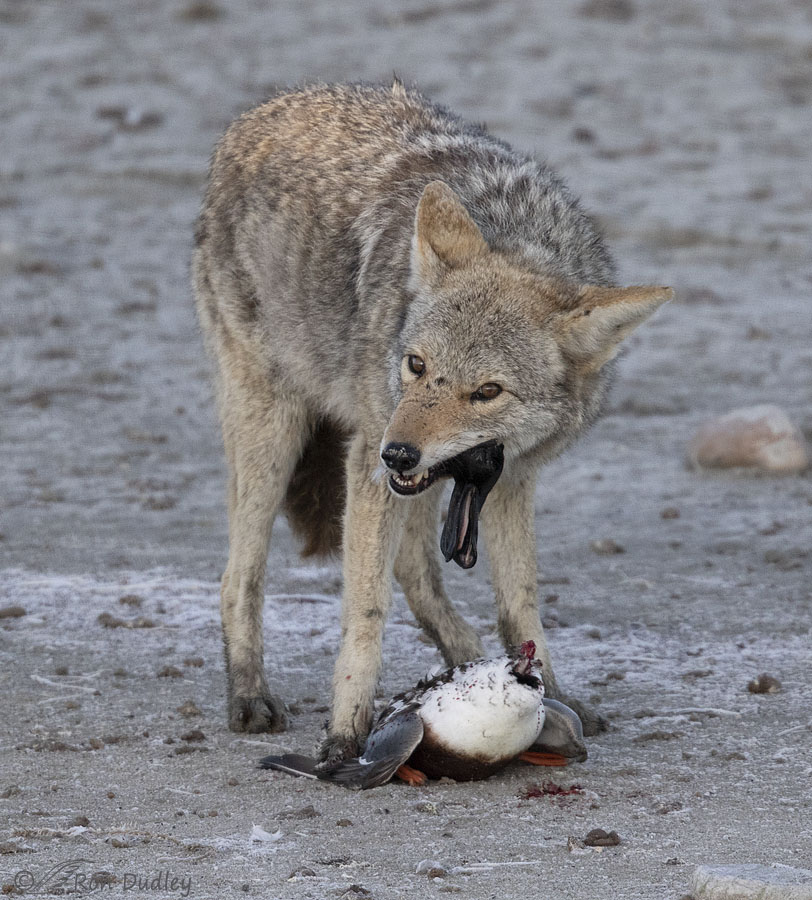
with some difficulty swallowed the head and neck whole.
It was unsettling to watch the body of the duck flop around after the head and neck had been removed. The coyote had the duck’s right wing pinned down but the rest of it’s body was free to thrash around, and it did. It brought back rather unpleasant memories of chopping heads off of chickens with a hatchet when I was a kid on the Montana farm.
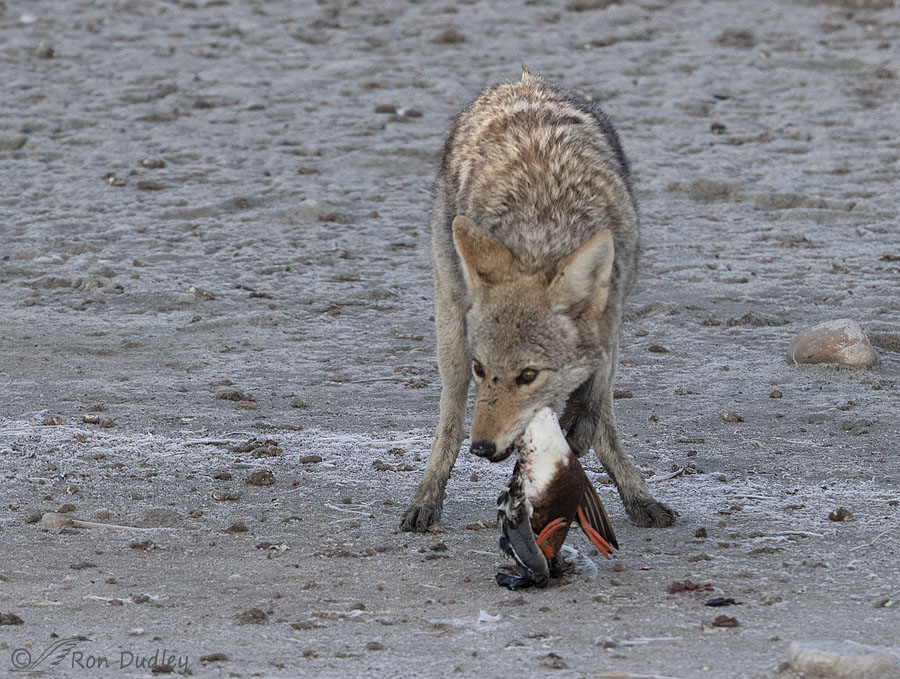
Then he chewed the neck stump off of the duck’s body and…
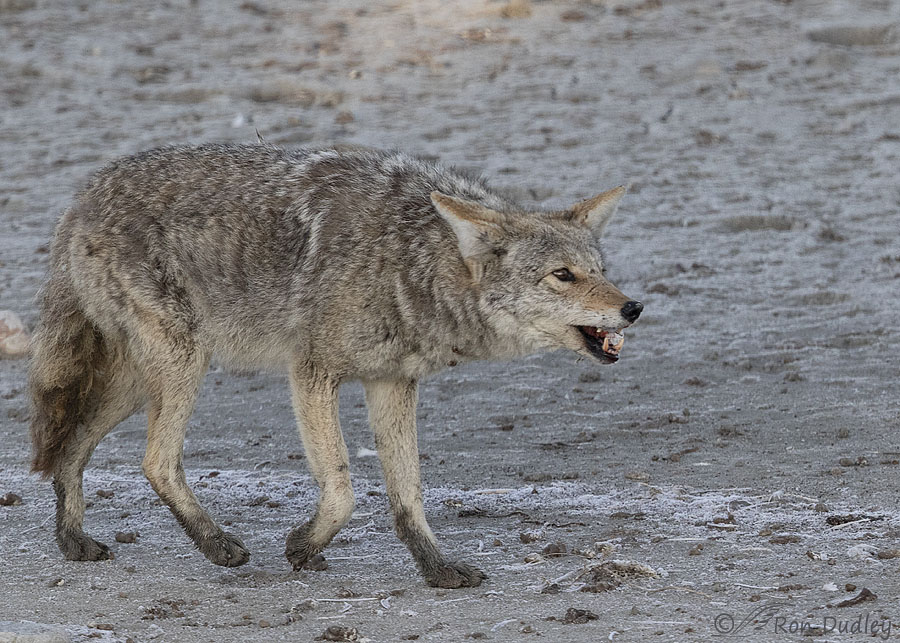
walked away with the stump still in his mouth, leaving the rest of the duck behind.
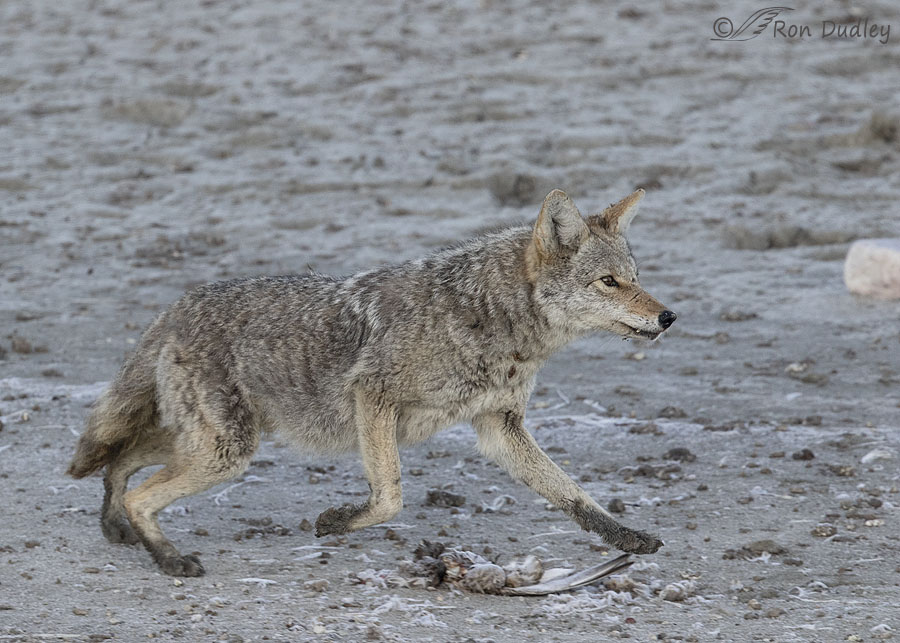
He swallowed the stump and then walked slowly east for some distance before something in front of him near the bridge caught his attention (yes, that’s a bird wing below him). Almost immediately he broke into a run toward it.
It was another, apparently disabled but still alive, male Northern Shoveler that made no attempt to avoid the coyote.
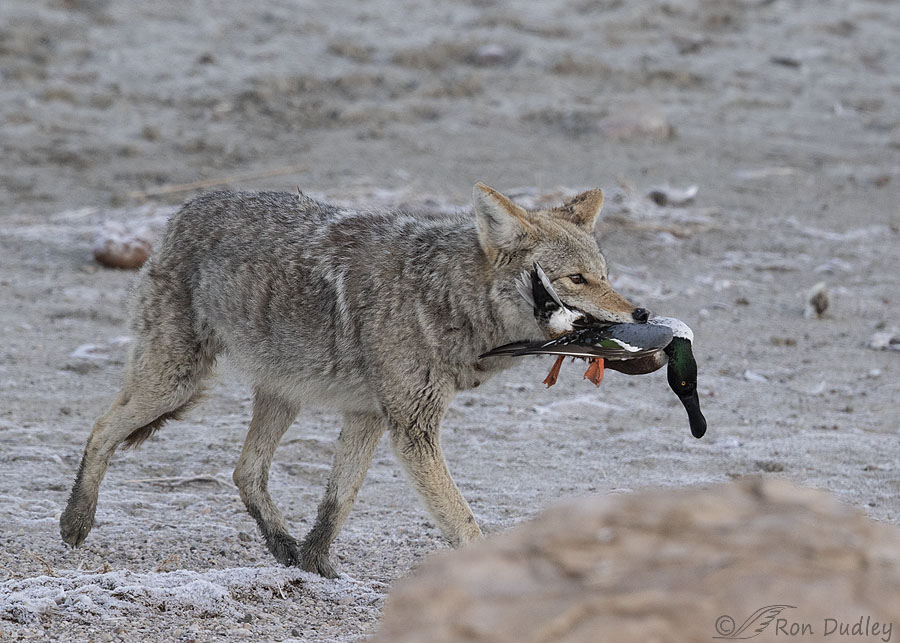
The coyote carried the duck a short distance and dropped it behind the out of focus large boulder at lower right. Then the coyote walked back west in the direction he had come from, leaving the shoveler behind the rock where I couldn’t see it.
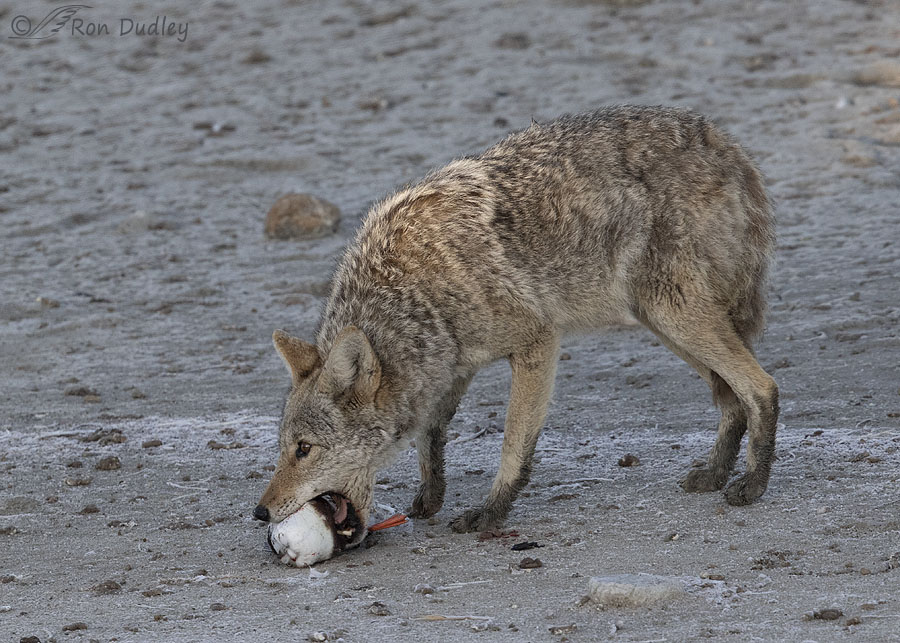
He returned to the first shoveler he’d beheaded earlier and carried it back west in the direction of the island. Soon he was so far away I turned my attention to photographing ducks in flight that were nearer to me.
He was gone and out of my sight for over four minutes before he returned to…
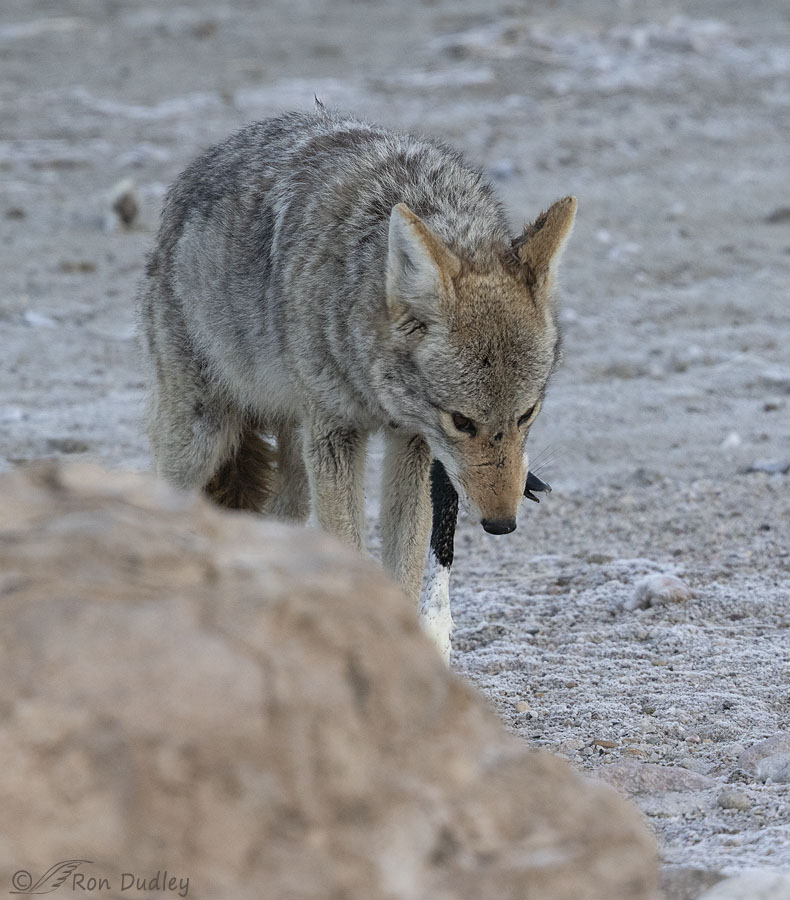
the male shoveler that he had stashed behind the rock earlier. To my great surprise the duck was still alive.
He pinned the duck’s body down with his front feet, bit the neck a time or two, and then pulled upward with the duck’s head in his mouth which quickly and efficiently…
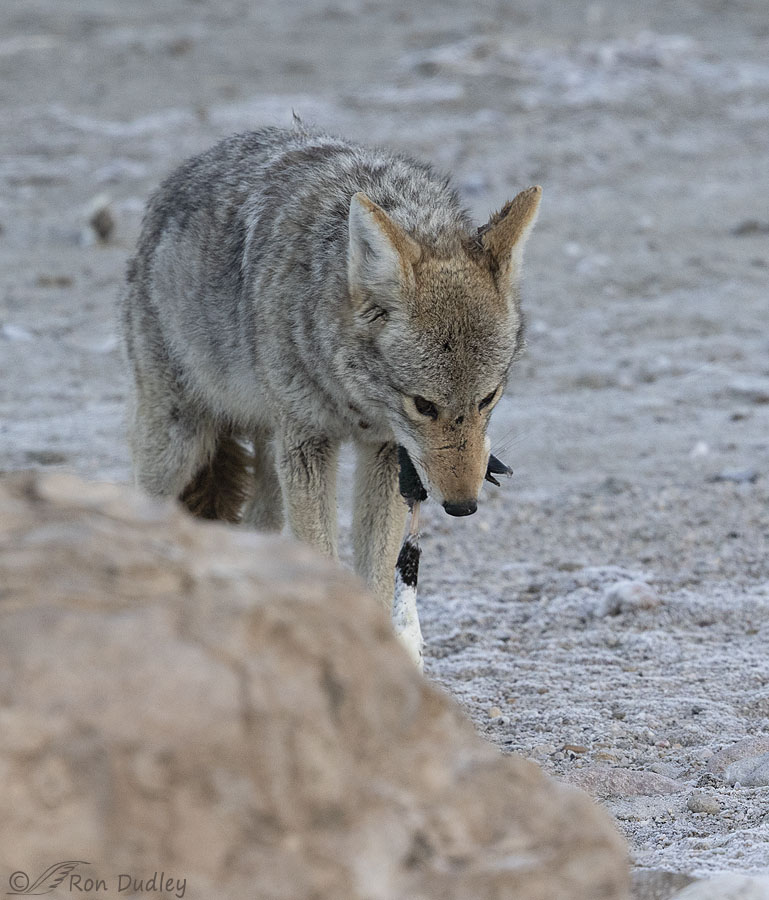
amputated the head.
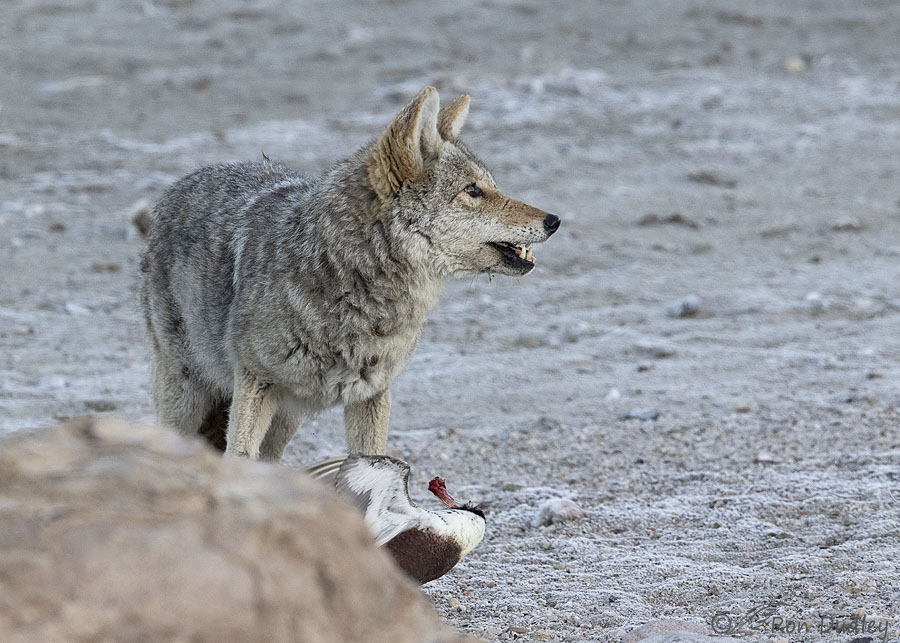
The duck’s body and wings continued to thrash around. At this point the head, chewed up a little but still whole, remained in the back of his mouth and unswallowed.
I keep coming back to this photo – it both disturbs me and mesmerizes me. There’s just something about that poor, thrashing and headless duck…
It was taken at the moment he noticed a huge and incredibly noisy construction truck (they’re laying a pipeline on the causeway) approaching from the east on the road. It frightened him very much so he left the duck’s body behind the rock and began to run to the west in the direction the truck was heading.
But the truck was going pretty fast and quickly passed the coyote so he…
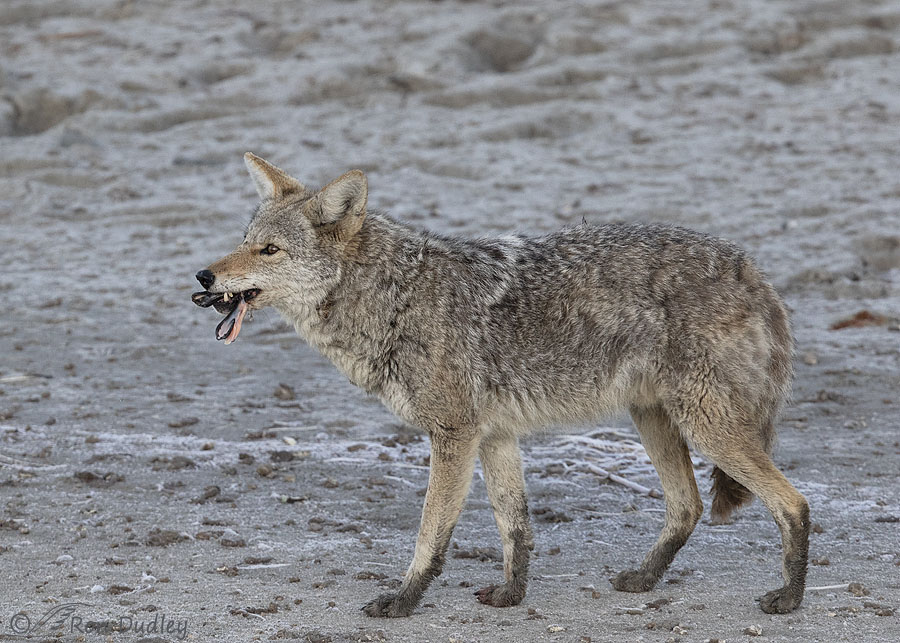
stopped in his tracks and watched the receding truck with the duck’s chewed up bill sticking out of his mouth. He swallowed it and then…
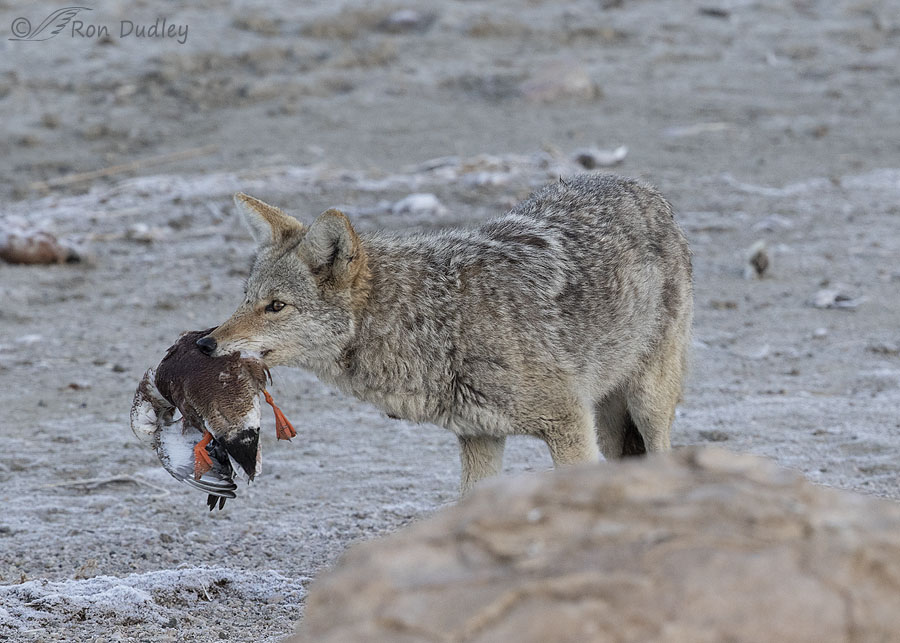
went back to the carcass behind the rock, retrieved it, and
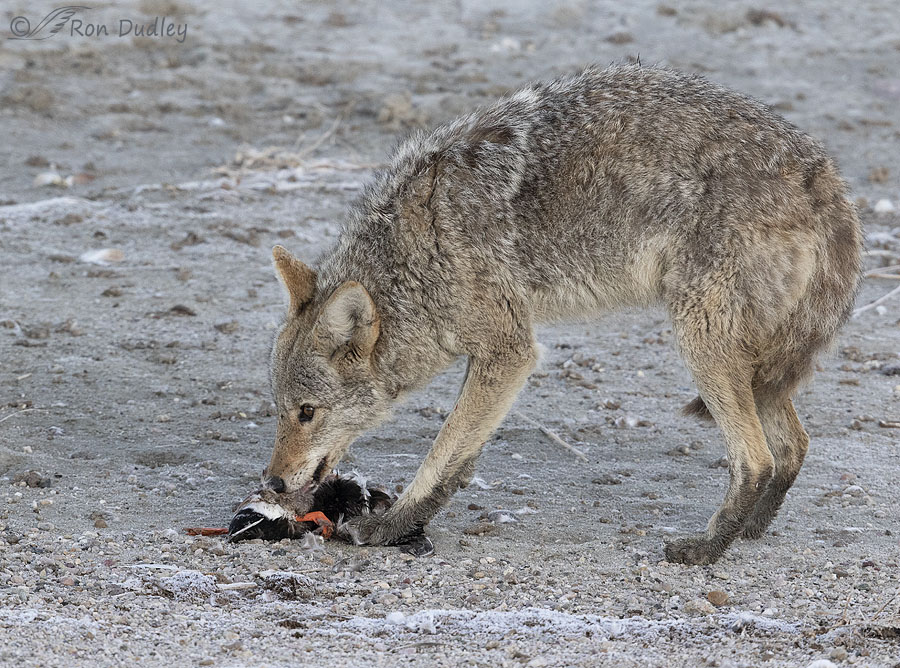
this time he actually ate a significant portion of the duck’s body before abandoning the rest and disappearing in the direction of the island.
OK, I’ve documented the behavior but I sure can’t explain it. At this point I have two primary questions.
- Why do these coyotes so often eat only the head of their duck prey and abandon the rest, either permanently or temporarily? I can speculate but that’s all I’d be doing – speculating (the potential value of brain-eating?). I tried to research the behavior but came up empty.
- Why does there seem to be so many disabled ducks on the beach? Once again I can speculate – perhaps they’re diseased or maybe coyotes had disabled them previously. I dunno.
I suspect I won’t be able to see or photograph this behavior again. Up until a few days ago there were hundreds of thousands of ducks on and near the shore of the causeway west of the bridge but by early yesterday morning about 90% of them were gone. And by the time I left the island later in the morning even more of them were gone. It’s been warming up so there’s more open water so perhaps they’re dispersing for that reason.
Maybe some of them return later in the evening. Given my penchant for shooting early in the morning that’s a possibility I can’t confirm.
Ron


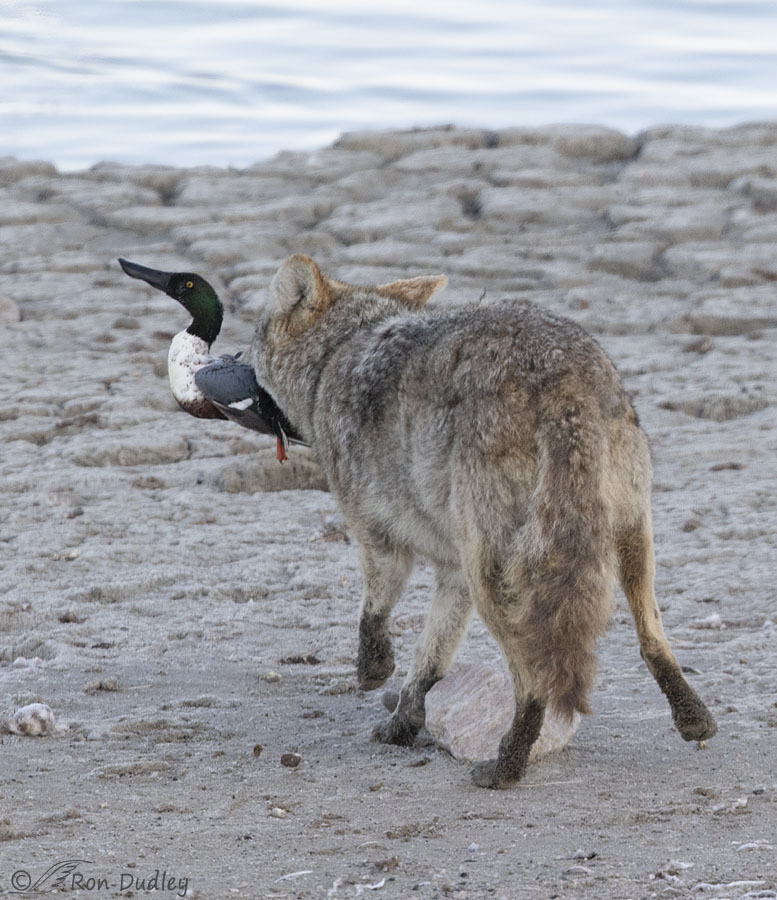
One. Pay attention to the warning in the topic. I wasn’t grossed out by the pictures until the pulled neck.
I wasn’t grossed out by the pictures until the pulled neck. 
Two. DO NOT READ THE COMMENTS. lololol Y’all were far worse than the pictures.
I now have an image of a chook trying to drive a truck.
Weird…
This is on the website https://wildlife.utah.gov/whirling-disease.html
Avian influenza
West Nile virus
Avian cholera
Avian botulism
Avian tuberculosis
Avian salmonellosis
Avian pox
I wonder if you should report this.
I wonder if the coyotes or other wildlife are susceptible.
Lyle, next time I’m on the island I’ll mention it to them. But a), the rangers (DNR) including the biologist, drive right by that spot multiple times each day so I’m sure they know what’s going on and b), I know from experience that there’s nothing they can do about it. To some degree it seems to happen most every year around the lakeshore.
Several years ago it was West Nile Virus that was killing a very large number of our Bald Eagles and they had to just let it play out.
Lyle, just to be safe just a few minutes ago I talked to DNR on the phone and told them what’s going on. They requested that I send them the links to my two posts on the subject, which I did.
I’ll report back if anything comes of it.
I think this and the previous posting document some interesting behaviour that leads one to ponder the reasons for how the coyotes are behaving (it is obviously not random) and why the ducks are down but not out. I also suspect botulism is the cause of the latter.
I am sure subsequent observations by you and others will reveal some interesting information.
Once again, a fascinating and useful post – well done
Thanks, Gary. Botulism certainly seems like a possibility.
Zombie coyotes? (Must. eat. braaaaaiiiinnnns.)
I wonder why the shovelers are such easy targets. ‘Tis a mystery.
” Zombie coyotes”
Who knows, Marty. Who knows…
Bill//keratin/pepsin. Your logic is simply amazing
Lyle, maybe that comes from teaching so many years when there’s always a student or two waiting to call you out if you’re illogical. Or just plain wrong. And I’ve been both, more than once at the same time.
More interesting photos, Ron.
My experience with brown bears and bobcats, is they head the brains first.
In the case of brown bears eating salmon, when the salmon are easy to catch, the bears take a bite of the head, eating the brains, and then discard the rest of the salmon — think about that by the weight of the brain compared to the weight of a spawning sockeye salmon…
The theory I have heard is that the brains are very high in caloric value, and easy/quick to eat.
With bobcats, I have watched them first eat the head rabbits. In two cases the bobcat that made the initial kill ate the head/brain and then left the rest of the rabbit to its littermate and mother.
I am thinking this might be the case here since the coyotes seem able to easily catch the ducks. Why deal with plucking feathers when you can get the high-calorie brain meat faster, and the ducks are easily caught?
Here are two images of the salmon and bears (the second one is graphic). The sides of the river are littered with salmon with their brains removed when the spawning salmon are easy to catch.
Bear eating brain first
bear killed salmon, brain and skin eaten (graphic)
Ed, I’ve thought all along that was a possibility. I wonder if we’ll ever know for sure.
One thing makes me a little skeptical. With bears it’s a well known behavior and it’s documented often. Very often. But I can find no reference to the same behavior in coyotes.
Ron,
I wonder if the reason you may not see any documentation with coyotes is that there may not be many observations where the food is plentiful as with these ducks?
I have watched coyotes eating gophers of plenty when the fields are irrigated, however, to eat the gopher is just a big gulp/swallow, so not much work is involved once they catch it.
What are some other situations where coyotes have easy prey? Perhaps when a pond is drying up and there are lots of fish in the mud pool left behind, or when a coyote(s) gain access to chicken coop (not sure how common this actually is…).
Your photos and observations are worth reporting to the wildlife biology community. Very interesting, although disturbing to watch.
I hope that you are able to observe some of these same coyotes very soon.
In googling information on botulism, I learned that the toxin easily survives
freezing, so that’s probably not the reason for stashing/caching the rest of
the body, so….. ?
I’m sure it isn’t the reason, Kris.
Fascinating but I do feel (so much) for the disabled and literally sitting ducks. And yes, I do wonder why the head. And the sometimes caching, sometimes discarding.
So many questions…
…and so few answers.
Ron, I have been having trouble with a predator taking chickens ….. in reading about this, I learned that foxes often decapitate their prey to silence them …. I wonder if this is not the same strategy?
Very educational post Ron! I’ve never killed a chicken but my husband and daughter have done their share. So for those who are interested, here is a link to Mike The Headless Chicken Festival coming up Memorial Day weekend in Fruita, Colorado https://www.miketheheadlesschicken.org/mike
Marian, I remember hearing about Mike on one of my many trips where I had to drive through Fruita on my way to visit my sister in Montrose, CO.
Here’s more about Mike from Wikipedia:
“On September 10, 1945, farmer Lloyd Olsen of Fruita, Colorado, was planning to eat supper with his mother-in-law and was sent out to the yard by his wife to bring back a chicken. Olsen chose a five-and-a-half-month-old Wyandotte chicken named Mike. The axe removed the bulk of the head, but missed the jugular vein, leaving one ear and most of the brain stem intact.
Due to Olsen’s failed attempt to behead Mike, the chicken was still able to balance on a perch and walk clumsily. He attempted to preen, peck for food, and crow, though with limited success; his “crowing” consisted of a gurgling sound made in his throat. When Mike did not die, Olsen instead decided to care for the bird. He fed it a mixture of milk and water via an eyedropper, and gave it small grains of corn and worms.”
This is an amazing story, thank you. I’ve had to cut off the heads of several chickens and was always awed by how much they ran around!
Thank you so much for this glimpse of things I’d never get to see! I so appreciate the beautiful (usually) window you provide! I’m looking out a crusty snow on the Northern forest floor. Bobcat (I think) tracks in the yard and lots of birds and squirrels. I do hear coyotes sometimes and there are other well hidden animals. May they continue to hide.
Mary, I envy the birds and critters in your yard.
Thanks for the warning! Couldn’t take my eyes off these photos Ron. Fascinating behavior expertly captured.
Kathleen, I learned my lesson about providing warnings for photos like these some years ago.
Nature never ceases to amaze. Thanks Porcupine for your answers regarding digestion etc. What a difference when you think of a hawk pulling out those feathers before eating and the coyote just taking down the whole bird bill and all. What a remarkable digestive system.
What time do you start photographing in the morning? I think I will go out to a couple of our lakes where we have lots of ducks to see if our coyotes are doing the same.
Once again an excellent educational series.
“What time do you start photographing in the morning?”
Everett, it varies with the time of year. I’m nearly always at my shooting destination just before sunrise so that means getting up VERY early, especially in early summer when my destination is far away. I can “sleep in” a little in winter.
Interesting and Porcupine’s comments are enlightening. Love the education! Grimace a bit at it all but living in the country…….didn’t grow up “in the country” and was the original “it followed me home” kid so it’s been an adjustment….
Grimace a bit at it all but living in the country…….didn’t grow up “in the country” and was the original “it followed me home” kid so it’s been an adjustment….  Fascination and having an hierarchy of what is more important to me helped with that…;)
Fascination and having an hierarchy of what is more important to me helped with that…;)
Judy, country/farm living is certainly a different lifestyle. Personally I miss it.
The brain is the most nutrient dense part of the body and is preferred by lots of predators when they have a bounty of prey to feast on. Grizzlies on salmon rivers will eat the brains out of the fish they catch and leave the rest. If they are hungry and fish are scarce, they will eat the entire fish.
It sounds like you may have a botulism problem on your lake. It causes a paralysis like you are describing and is found in areas where an ecosystem is undergoing changes and feeding opportunities are unfamiliar. Perhaps your Utah Fish & Game would be interested since water fowl are birds from which they derive income by licensing people to kill them.
Porcupine, botulism is a definite possibility, as are other diseases. It’s far from unusual for botulism to break out along the shore of the lake where the mud is often anaerobic, perfect conditions for Clostridium botulinum to thrive.
I’ve seen old photos from roughly the 1920’s where dead ducks and shorebirds were so thick on the dried mud that the caption said that a person could walk for miles and step on a dead bird with every step. Looking at the photos I can believe it.
Also curious to know how the head/skull and the ducks bill pass through a coyotes digestive system. Obviously it does, but ??
The stomach acids of canines have no trouble dissolving bird bones.
I believe Porcupine is right in her response. And the bill is made primarily of keratin, a protein, so it should be even easier to digest than bird bones. The digestive enzyme pepsin is very efficient at breaking down proteins.
I am wondering if these ducks have been wounded by hunters and escaped that plight only to be found wounded by the coyotes ??
Gary, duck hunting isn’t allowed on the island. And it’s no longer allowed along the causeway. Besides, the hunting season is over.
Another exceptional series, Ron. Thank you.
Thanks, Cathryn.
Wowzer! Yes, Wowzer! Disturbing yes but this photo series and accompanying commentary are so valuable. And the quality of the photos is just superb. Like everyone else, this has my head buzzing with possibles. Let’s hope that in the near future some enterprising person will do a full scale study to follow up on this with rigour to see if the questions can be answered.
“this has my head buzzing with possibles”
Granny Pat, I’ve had those “possibles” in my head for three days now.
WOW!! Excellent post and great images.
Thanks, Dick.
My thoughts: the head has less feathers and is tastier with more bodily juices, plus the duck bill is keratin mostly, perhaps a delicacy? It takes lots of time and more vulnerability (being exposed) to eat a duck without getting a mouth full of feathers, so that “stressful hard work” is saved for a better time . . . I, too, helped kill chickens with an ax on a tree stump on my Pennsylvania farm as a child, very traumatic.
Lots of possibilities, Terri.
Speaking of traumatic, one of the chickens we beheaded actually, somehow, jumped into the nearby pickup that had its door open. Blood everywhere – what a mess to clean up. True story.
Yep, blood everywhere! They sure could move and hop faster dead than alive!
YUK! Those “nerves” do keep going for awhile…..great way to “bleed them out” BUT pretty primitive…….
At least it’s quick…
As I learned from EC – wowsah. Sorry if I misspelt it. Two highly personal comments. I live in a suburb where we are taught to loathe and fear the coyote. May have to change that rule. I am beginning to admire them hugely. Second once again I have gone down a rabbit hole to read about the value of eating brains and now I will be late for work, despite that – thank you Ron. My own brain is stretched so must I feel dizzy. Thank you again.
Thank you, Frances. Please apologize to your boss for me!